Are you a wholesale customer?
News
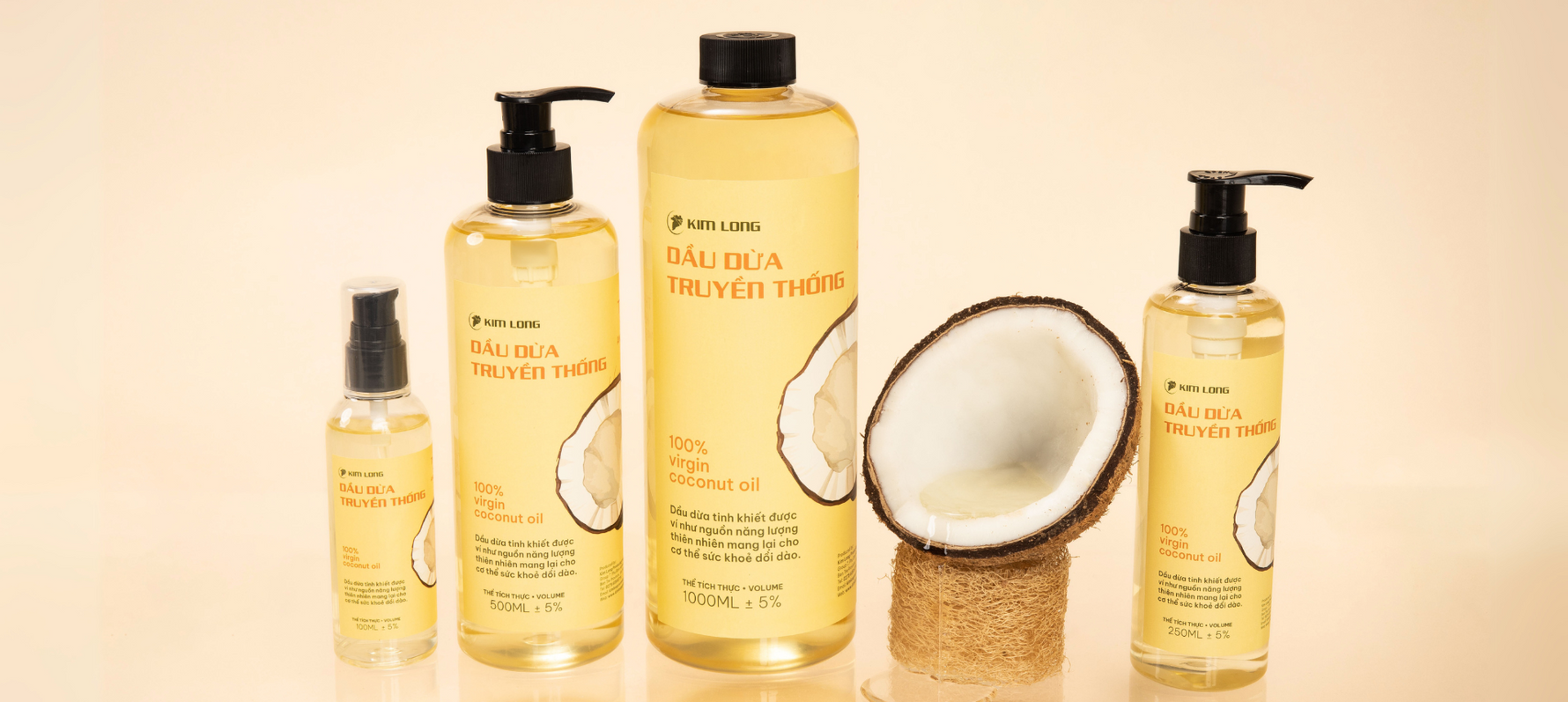
Benefits Of Virgin Coconut Oil For Health & Beauty
by Nguyễn Thanh Duy
Virgin coconut oil – the secret to health care, skin and hair beauty and safe cooking. Discover the "golden" nutritional ingredients and comprehensive applications every day.
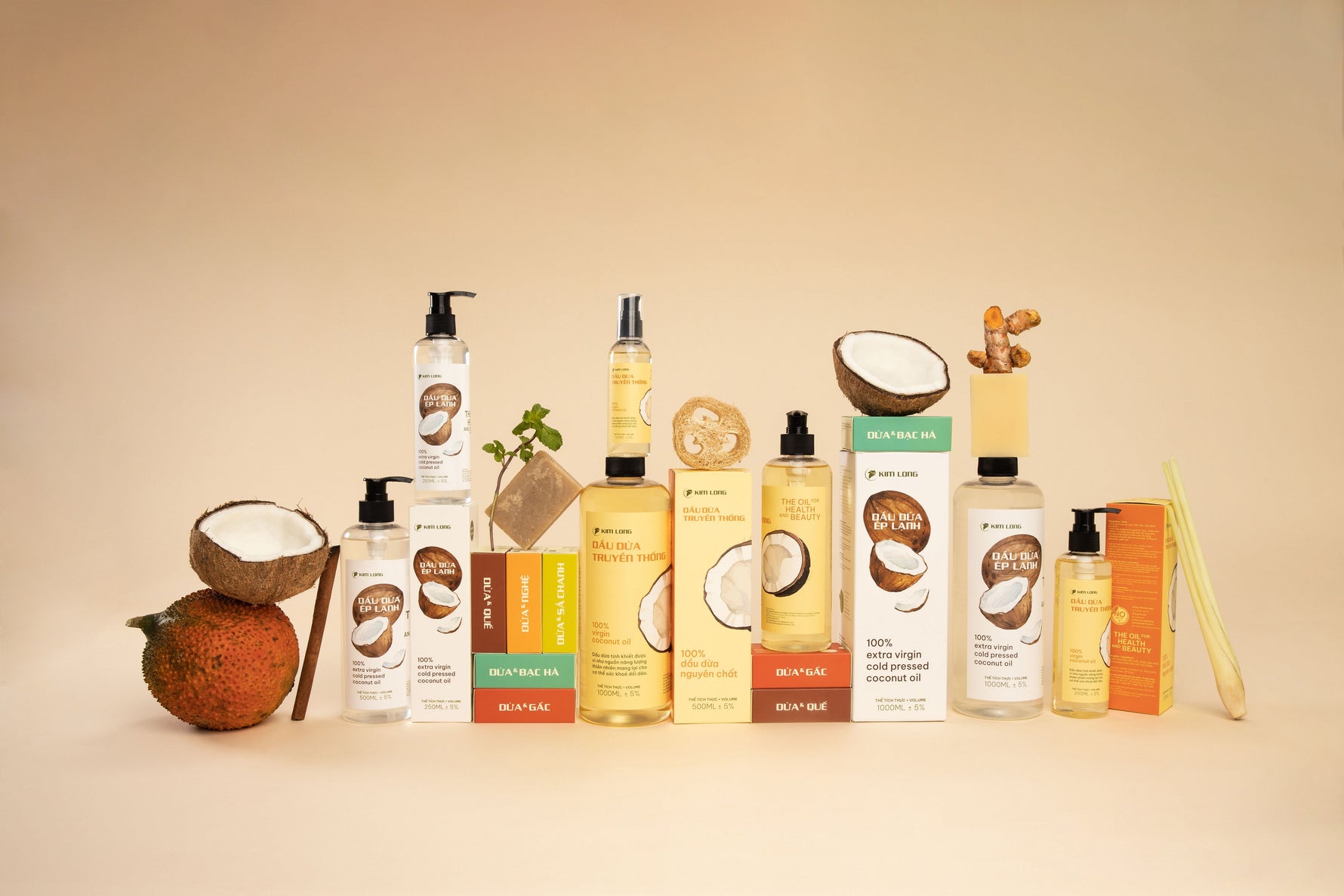
How to properly preserve coconut oil to keep its quality intact
by Nguyễn Thanh Duy
Do you know how to properly preserve coconut oil? Discover simple tips to help preserve the natural aroma and nutrients of coconut oil, ensure safety when using and extend the storage time. Apply tips from Kim Long now!
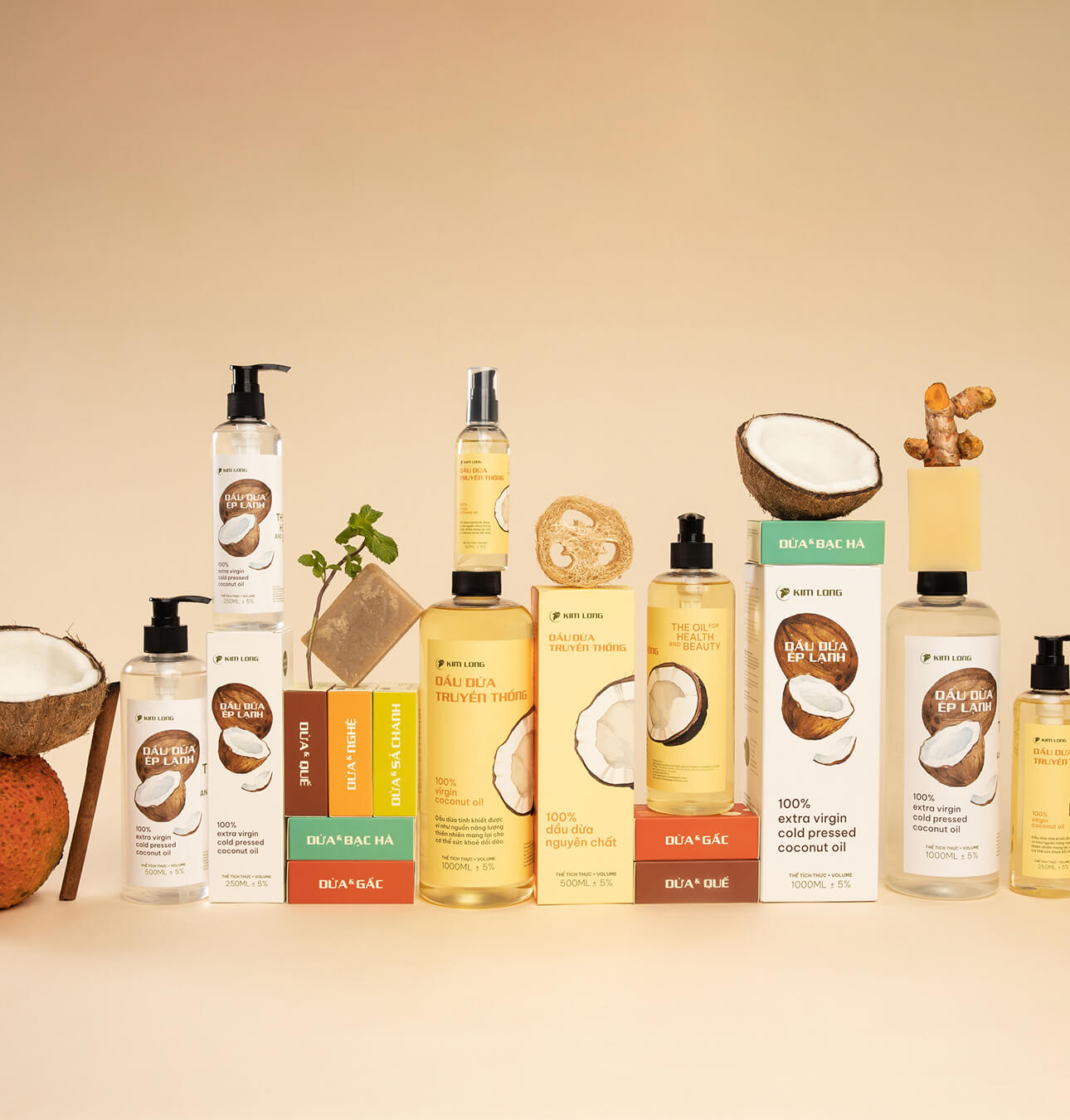
What color virgin coconut oil is best?
by Nguyễn Thanh Duy
What color of virgin coconut oil is the best? The answer lies in the purity and the extraction method. Learn how to distinguish real coconut oil by color to choose the right product that is good for your health.
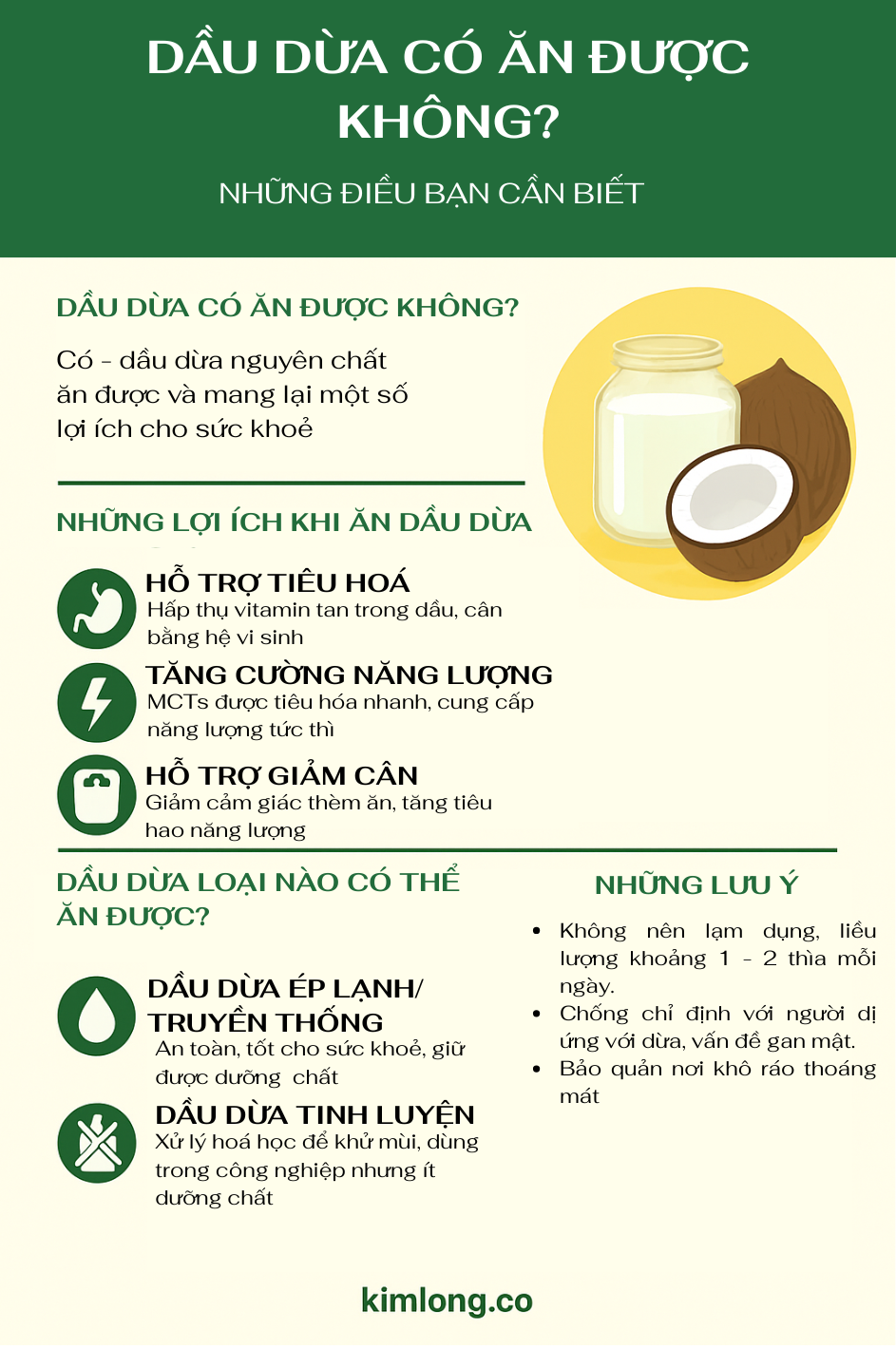
Is Coconut Oil Edible? What You Need to Know
by Nguyễn Thanh Duy
Is coconut oil edible? The answer is yes! But not all types are safe and good for your health. This article helps you understand how to use virgin coconut oil in your daily diet, along with the benefits and important notes when using coconut oil for eating.
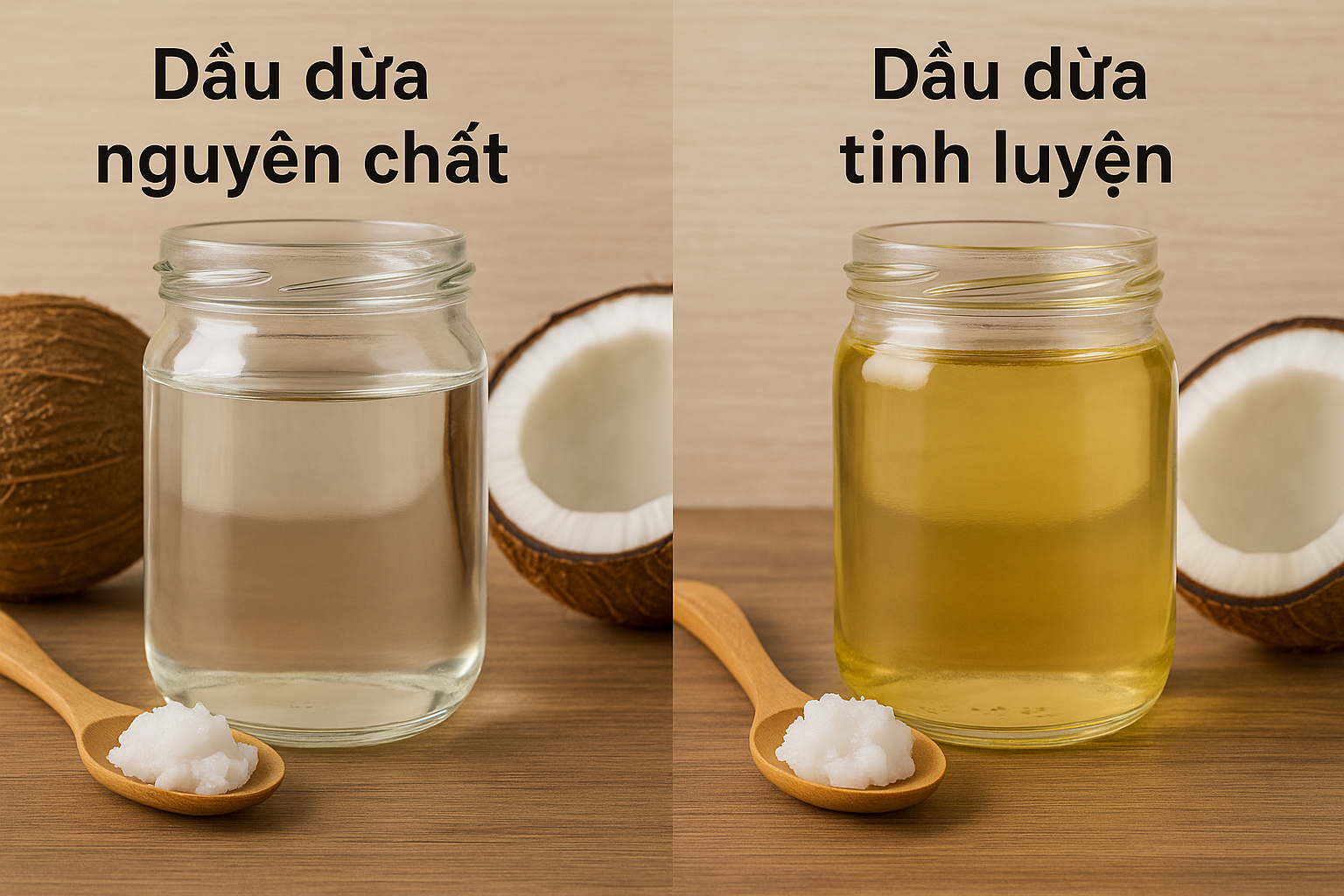
What is Virgin Coconut Oil? Easily Distinguish It From Refined Coconut Oil
by Nguyễn Thanh Duy
What is Virgin Coconut Oil? Easily Distinguish It From Refined Coconut Oil
Coconut oil has become a familiar ingredient in the kitchen and beauty corner of many Vietnamese families. However, there are two popular types on the market: virgin coconut oil (VCO) and refined coconut oil (Refined Coconut Oil) . How are they different and how to distinguish them? As an experienced coconut oil producer, I will help you clarify this issue.
Virgin Coconut Oil (VCO)
Virgin coconut oil , as the name suggests, is the oil extracted from fresh coconut meat (fresh coconut meat) , through mechanical or natural methods, with little or no use of heat and without chemical refining .
Main production process:
Natural fermentation method: Fresh coconut milk is left to ferment for about 12-16 hours, the oil layer will float to the top and be collected. This method gently breaks down the carbon bonds in the oil structure, increasing its ability to penetrate the skin, hair and body, thereby allowing medium-chain fatty acids such as Lauric Acid, Capric Acid, Caprylic Acid - famous for their antibacterial, anti-inflammatory and cell-nourishing properties - to be absorbed faster and more effectively. At the same time, the oil retains its vitamin E, polyphenols and natural antioxidants intact.
Centrifugal method: Fresh coconut milk is pressed from coconut meat, then a high-speed centrifuge is used to separate the oil from the water and coconut pulp.
Cold-Pressed method: Fresh coconut meat is grated, dried at low temperature (to retain maximum nutrients) and then put into a mechanical press to extract the oil.
Traditional heating method (Wet Milling): Fresh coconut milk is gently heated over low heat until the water evaporates, the oil is collected. This method can make the oil slightly yellow and has the characteristic sweet aroma of coconut oil.
Characteristics of pure coconut oil:
Flavor: Has a fragrant, characteristic smell of fresh coconut. Rich, pure taste.
Color: When in liquid form (above 24-25°C), the oil is clear like water. When solidified (below 24°C), the oil is pure white or opaque like wax.
Ingredients: Retains many valuable nutrients such as lauric acid, vitamins (especially vitamin E), minerals and antioxidants (polyphenols) due to being less affected by high temperatures and chemicals.
Smoke Point: Lower than refined oil, around 177°C (350°F).
So, What Is Refined Coconut Oil?
In contrast to virgin coconut oil, refined coconut oil is usually produced from dried coconut meat (copra) . Copra is often not as hygienic as fresh coconut meat, and can be contaminated with dust and mold during the drying process. Therefore, the oil pressed from copra must undergo the refining, bleaching, and deodorizing process – abbreviated as RBD – to remove impurities, unpleasant odors and make the oil usable.
Production process:
Copra Oil Pressing: Dry coconut meat (copra) is pressed by machine to obtain crude oil. This crude oil is usually pale yellow to brown in color, has an unpleasant, pungent odor and contains many impurities.
Refining: Crude oil is treated with chemicals (such as lye) or physical methods (using clay) to neutralize free fatty acids and remove impurities.
Bleaching: The oil is filtered through bleaching clay to remove the pigments, making the oil clearer and lighter in color.
Deodorizing: The oil is treated with high temperature steam and vacuum to completely remove the natural coconut smell and taste. Some processes may use chemical solvents.
Characteristics of refined coconut oil:
Taste: Almost odorless or very light odor, no characteristic coconut flavor.
Color: Usually lighter yellow or transparent if the bleaching process is good. When solidified, it is also white but sometimes not as pure white as pure oil.
Ingredients: Still retains the medium chain fatty acid (MCTs) such as lauric acid but the content is lower than virgin coconut oil, vitamins, minerals and antioxidants are often very low or absent due to high heat and chemical processing.
Quick Comparison Chart: Virgin Coconut Oil vs Refined Coconut Oil
Criteria
Virgin Coconut Oil (VCO)
Refined Coconut Oil
Ingredient
Fresh coconut rice
Copra
Production process
Fermented, Cold Pressed, Centrifuged, Hand-Cooked (less processed, no chemicals)
Refine, bleach, deodorize (RBD)
Color (liquid)
Transparent
Color yellow to brown
Color (winter)
Pure white/opaque white
Ivory white, sometimes not as white as VCO
Taste
Fragrant, characteristic coconut flavor
Odorless, tasteless or very mild
Smoke point
Lower (~177°C)
Higher (~204°C - 232°C)
Nutrition
Rich in vitamin E, antioxidants
Less vitamins, antioxidants
Lauric Acid & MCTs
High content
Still there, but reduced
Price
High price
Cheap
Common Use
Eat raw, mix in salad, skin/hair care, low temperature cooking
In food and cosmetic industry
Which Type of Coconut Oil Should You Choose?
Choosing between virgin coconut oil and refined coconut oil depends entirely on your intended use and personal preference :
If you want to get the most out of coconut oil's natural nutrients, use it for skin care, hair care, eating it directly, making smoothies, mixing it in salads or cooking dishes that don't require too high a temperature and love the taste of coconut: Choose virgin coconut oil (VCO)
If you need an oil for industrial confectionery and cosmetics production but don't want the finished product to smell like coconut, or simply want a more economical option: Refined coconut oil is the right choice.
Note when buying:
Read product labels carefully: Look for terms like "Virgin", "Extra Virgin", "Cold-Pressed" for virgin oil, or "Refined", "RBD" for refined oil.
Check ingredients: Make sure there are no unwanted additives or preservatives.
Choose a reputable brand: Prioritize manufacturers with clear processes and quality certification (if any).
Conclude
Understanding the difference between virgin and refined coconut oil will not only help you be a smart consumer, but will also ensure you use the right oil for the right purpose, maximizing your health and cooking benefits. Virgin coconut oil retains its natural flavor and nutrients, while refined coconut oil is a more practical choice for high-heat cooking and when you don’t want the coconut flavor.
Hopefully this information will help you feel more confident when choosing and using coconut oil! If you have any other questions, don’t hesitate to ask.
Wish you always healthy and have the best choices for yourself!

Coconut Oil – From Raw Material Export to Journey of Creating Sustainable Value
by Tuan Nguyen
🥥 A forgotten profession…
For many years, Vietnamese coconut mainly relied on exporting raw coconuts with the main markets being China, Thailand... where the true value of coconuts is fully exploited.
The valuable products were sold at very low prices, and the local farmers who put in so much hard work received little value in return.
🥥 ...To the revival from the native
Kim Long does not choose a short-term path. We choose a long-term journey: deep processing locally , enhancing the value of local products and creating products that meet international standards - from the hands of Vietnamese people.
Kim Long Coconut Oil is the crystallization of a strict production control process, utilizing the freshest ingredients from Mo Cay Bac, Ben Tre - known as the "coconut capital" of Vietnam. Here, instead of exporting raw coconuts, the coconuts are brought to the factory, through the hands of skilled workers, they become pure coconut oil products , serving both the health care and beauty needs of domestic and foreign consumers.
🥥 Creating livelihoods for rural women
Behind each Kim Long product is a familiar yet touching image: middle-aged rural women – with calloused hands but eyes that are always steadfast and full of faith and hope for a bright future.
Many of them used to be seasonal workers with no stable income. But when they joined the production line, they got jobs and stable income, most importantly the pride of contributing to creating products chosen by domestic and foreign consumers.
This is not just a job. This is a revived faith . It is a small dream of a mother, a wife – striving every day for the family, for the future of her children.
🥥 Spread value - keep identity
Kim Long is not just a coconut oil brand. We are also an individual in a group of people who love their homeland, working together to preserve traditional crafts , protect the environment , improve the quality of rural life , and most importantly – bring the image of Vietnam to the world with high-quality products, imbued with national identity.
Each Kim Long product is produced in a sustainable way, without chemicals or preservatives , ensuring absolute safety for users and being environmentally friendly.
🥥 Kim Long – Traditional values, nurturing the future.
True beauty lies not only in the bottle of pure oil but also in the process of creating it.
We believe that luxury comes from sincerity, passion and true value – things that cannot be measured by price, but by emotion and trust.
KIM LONG COCONUT OIL KIM LONG AGRICULTURAL PRODUCTS PRODUCTION & TRADING COMPANY LIMITED 📞Hotline: 0275 659 6779 📧 Email: kimlongcoconut@gmail.com 🌐Website: https://kimlong.co 📍 Phu Binh Hamlet, Phu My Commune, Mo Cay Bac District, Ben Tre Province
#dauduakimlong #luxuryfromnature #phunuquevietnam #nghethucong #benvung #madeinvietnam
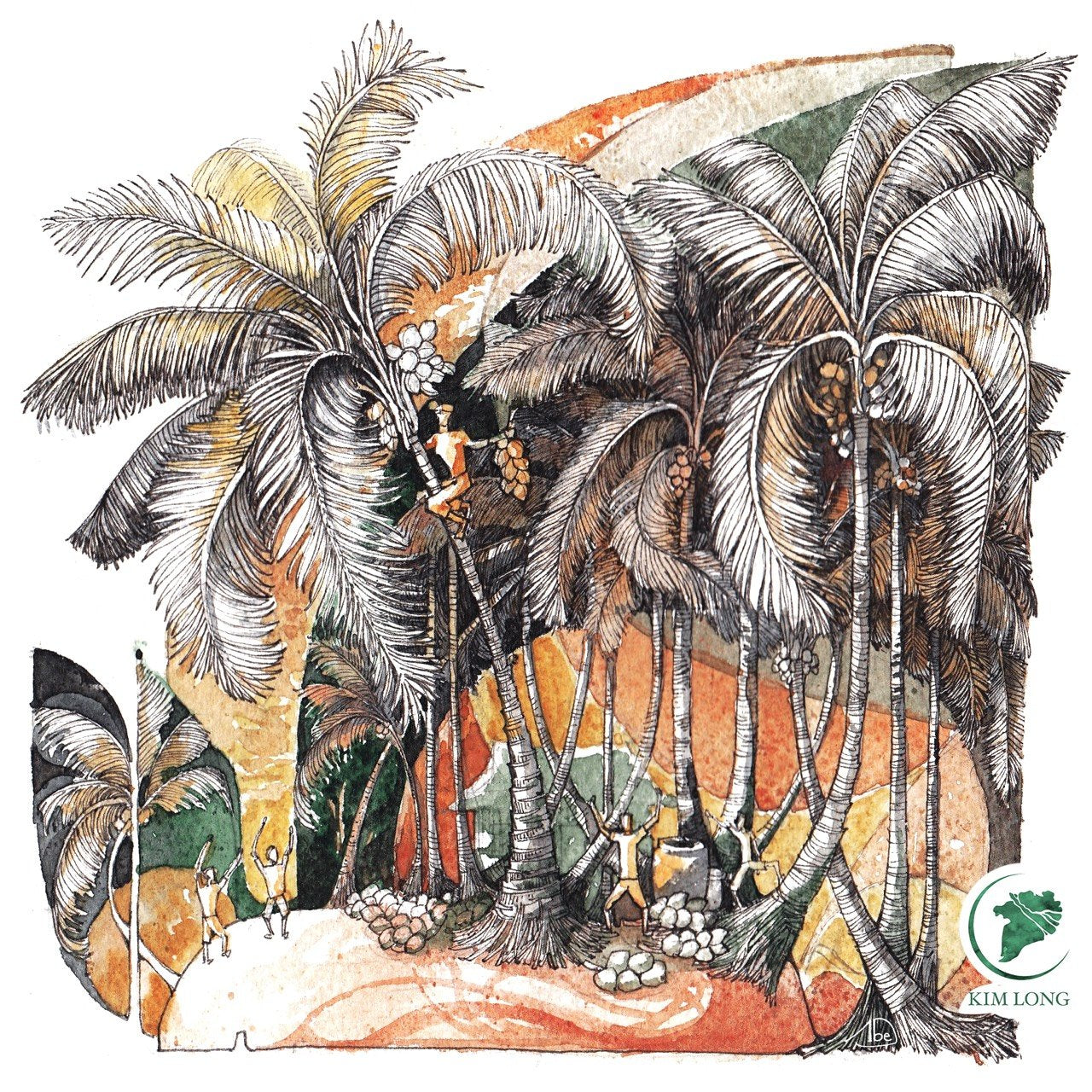
Picking coconuts... story of job, story of life
by Ba Thanh Huynh
🥥 Coconut picking – Requires workers to have good health and defense.
In the shade of the tall coconut trees in Ben Tre, there are people quietly making a living by one profession - picking coconuts .
Without modern machinery, their work is equipped only with a sickle blade, and bamboo tubes that can be connected together or disassembled when necessary. Coconut pickers come to this profession naturally, and the experience gained by those who come before them is passed on to those who come after them. The key to being a professional coconut picker is to know your own strength, be quick and smart, and know how to predict the direction of the falling coconuts to avoid them.
🥥 Coconut picking - a job that requires age but is the livelihood of many generations.
Although picking coconuts does not require a high age limit, it does require good health, so most coconut pickers are only between 25 and 55 years old. No qualifications are required, just diligence, endurance and hard work - coconut pickers can generate millions of dong in income each day. For many rural people, this is a sustainable source of income - helping them to be financially independent, support their families, educate them and maintain the value of working with their own hands.
Despite the hardships and the constant danger of accidents, coconut pickers are still attached to their profession as a part of their homeland . Because they not only do business, but they also hold a large media industry , an important link in the labor chain that creates pure coconut oil products - the "white gold" that Kim Long respectfully brings to domestic and foreign consumers.
🥥 Honoring coconut picking – Honoring the value of indigenous labor
At Kim Long, we believe that luxury doesn't just come from packaging or production methods – it starts with real people , real labor , and real places .
Each drop of Kim Long coconut oil is the crystallization of sweat and labor from people from coconut pickers to coconut workers who pry open coconuts, grind coconuts, and cook oil.
Kim Long – Traditional values, nurturing the future.
We do not simply produce coconut oil. We build a sustainable ecosystem , create local livelihoods and contribute to bringing the Vietnamese coconut industry to the world - where each product is part of the story of labor value and national identity.
KIM LONG COCONUT OIL KIM LONG AGRICULTURAL PRODUCTS PRODUCTION & TRADING COMPANY LIMITED 📞Hotline: 0275 659 6779 📧 Email: kimlongcoconut@gmail.com 🌐Website: https://kimlong.co 📍 Phu Binh Hamlet, Phu My Commune, Mo Cay Bac District, Ben Tre Province
#dauduakimlong #nghehaidua #benvung #laodongchanchinh #nghethucong #luxuryfromnature #tuvungdatme

Coconut Oil – White Gold of Ben Tre Land
by Samdy Nguyen
Essence of Nature, Heritage from Mother Earth
🥥 Coconut – Symbol of Ben Tre Alluvial Land
For generations, coconut has not only been a product but also a living symbol of Ben Tre – the land known as the “coconut capital” of Vietnam. Coconut appears in every meal, every beauty care habit, and is deeply rooted in the cultural and spiritual life of the people of the Mekong Delta.
Among them, coconut oil is the most quintessential part - known as the "white gold" of nature , rich in nutrients, precious as a treasure bestowed by mother earth.
🥥 Cold Fermentation – The Method of Preserving Purity
Unlike other methods using heat presses from copra raw materials that easily change nutrients, Kim Long cold fermented coconut oil is produced using natural cold brewing techniques in a controlled environment, completely without using high temperatures or chemicals.
The result is every drop of oil:
Crystal clear
Keep the fresh, natural fragrance
Preserves good fatty acids such as lauric acid - which has antibacterial, anti-inflammatory properties and beautifies skin and hair in a safe, benign way.
🥥 The Intersection of Tradition and Modern Science
At Kim Long, we respect indigenous craftsmanship , where each skilled craftsman contributes to preserving the homeland's heritage, combined with modern inspection standards , to ensure:
Clean, closed production process
No chemicals, no preservatives
Transparent traceability of raw materials
Protect local ecosystems
The product is not only beautiful in form, but also has deep inner value - pure and natural.
🥥 Skin Care – Hair Care – Good for Digestion – And More
Kim Long coconut oil is not simply a beauty product. It is a sophisticated choice for a healthy lifestyle and towards comprehensive beauty from within:
Moisturizes and softens sensitive skin , anti-oxidant, natural anti-aging
Nourishes hair to be healthy, shiny and smooth , reducing breakage
Supports the digestive system , promotes nutrient absorption and enhances immunity
Soothes skin after sun exposure , cares for mother and baby, removes makeup, relaxes with massage...
The versatility of cold-fermented coconut oil makes it a “body care treasure” favored by housewives, beauty experts and those pursuing a green and luxurious lifestyle.
🥥 Choose Kim Long - Accompanying Sustainability
When you choose Kim Long coconut oil , you are not just choosing a beauty or health care product. You are accompanying us in:
Preserving local cultural identity
Creating sustainable livelihoods for Ben Tre households – especially middle-aged women in rural areas.
Developing organic, chemical-free agriculture
And spread the message of living in harmony with nature
Kim Long – Traditional Values , Nurturing the Future
From the silent coconut tree on mother earth to each drop of pure oil in the palm of the hand - it is a journey of love, preservation and aspiration to reach far.
Kim Long is not simply a brand – we are a living mission: bringing local values to the world , with true quality and true passion.
KIM LONG COCONUT OIL KIM LONG AGRICULTURAL PRODUCTS PRODUCTION & TRADING COMPANY LIMITED 📞 Hotline: 0275 659 6779 📧 Email: kimlongcoconut@gmail.com 🌐 Website: https://kimlong.co 📍 Phu Binh Hamlet, Phu My Commune, Mo Cay Bac District, Ben Tre Province
#goldendrae oil #men's aloe vera oil #cold aloe vera oil #bentre white gold #luxuryfromnature #skincare oil #high-class oil #naturebentre #green media

Choosing Coconut Varieties: From Sustainable Roots to Pure Nutrients
by Ba Thanh Huynh
Coconut is considered a perennial plant, can grow for a long time from 50 - 60 years, living in brackish water areas. For a long time, coconut trees have always brought the main income for many households, bringing joy to people in economic and social development.
Nowadays, agriculture is increasingly developing, access to technology and science is increasingly improved, however, the majority of farmers still grow coconuts in the traditional way, wasting natural resources, so productivity is not high and not effective.
To improve the efficiency of growing coconuts to achieve standard sweet quality, farmers need to strictly follow the cultivation process from seed selection, garden design, care and fertilization and take advantage of the effective business period.
1. Choose coconut varieties
Through actual surveys in many key coconut growing areas, every year our country is 4% saline, 3-4 months of salinity intrusion , but many coconut varieties grow very well, with high productivity, most of them are suitable for living in brackish water. Therefore, when choosing varieties, we should pay attention to the purpose of harvesting and economics to choose, mainly distinguishing between 2 groups of tall and dwarf coconut varieties:
+ Tall coconut varieties: Vietnamese coconut, bung coconut, strawberry coconut,..
+ Dwarf coconut varieties: Siamese coconut (green, red, green, nipple); slender coconut (green, yellow), Malay coconut, Tam Quan coconut, pineapple coconut (small fruit type),...
In addition, scientists have recently proposed adding a hybrid coconut variety . This is the result of crossbreeding between two varieties of tall coconut and dwarf coconut, so it has intermediate characteristics of the two groups of varieties mentioned above with outstanding advantages: early flowering, high yield, high oil content and the ability to adapt to some unfavorable environmental conditions.
2. How to choose breed
When selecting mother trees, it is necessary to pay attention to the indicators related to the factors that make up the yield. After surveying, mother trees are marked and monitored for 3 consecutive years to select trees with stable high yield. Specifically, the selection of mother trees can be based on the following characteristics:
– Tree age from 10 – 40 years;
– Evenly distributed foliage, tight leaf scars;
– Strong growing tree, straight trunk;
– Do not choose plants grown in special conditions: near barns, near toilets;
– There are many stalls on the canopy;
3. Coconut growing techniques
Coconut trees are usually very easy to grow, not too picky about soil, but will mostly grow best on soils rich in organic matter, alluvial soil, sandy soil and ideally soil with abundant potassium content.
Before planting coconut:
Gather topsoil to fill the mound with a width of about 1m.
The height of the mound does not necessarily have to be high.
Depending on the terrain, fill the mound to avoid flooding during the rainy season.
Depending on the condition of the empty or narrow ditch, arrange the plants appropriately. According to experts, to grow coconut trees for high productivity, they should be planted at a distance of 5m x 6m in 2 forms: 2 rows on both sides, crocodile tooth style, or 1 row in the middle.
For large trees with wide canopies, the distance and planting density between trees should be 6m or more.
After the soil is prepared
Dig a hole with a size equivalent to the size of the coconut seedling.
Next, apply basal fertilization: after preparing the planting holes and mounds, about 15-20 days before sowing, apply basal fertilization to each mound: about 20-30 kg of organic fertilizer, 100g of superphosphate, 200g of potassium, mix well and cover the mound surface.
Place the seedling down, cover it with soil and cover it tightly so that the wind does not shake the tree, causing the roots to break and fall easily.
4. Pay attention to harmful insects and diseases
5. Well-cared for coconut trees produce stable quality fruit and are an excellent source of raw materials for processing coconut products such as coconut oil.
– In the first 2-3 years of the tree’s life, always keep the soil moist for the tree to absorb and create good growth conditions. Do not let the soil get too dry, which will lead to a lack of water and poor growth. On the contrary, waterlogged soil, especially during the rainy season, will be an environment for insects and diseases to thrive, attack and damage the roots.
– During the young coconut tree stage, special attention must be paid to some dangerous insects that are harmful to the tree such as coconut beetles, king ants, coconut worms, and fungal diseases, leaf spot disease, top rot disease, etc., which will slow down the growth of the tree and affect the economy.
– Therefore, we must pay attention and regularly visit the garden to observe each coconut tree. If we detect any unusual signs, we must investigate carefully. After correctly identifying the cause of the damage, we must immediately take measures to prevent and stop it in time, not allowing it to spread and cause serious damage to the growth of the tree.
Note:
Basic construction period : When the tree is in the first 3-4 years, it is necessary to pay attention to the important issue of fertilizer for the plant. Because at this time, the coconut tree is still small, so it must be provided with enough nutrients for the tree to grow. Therefore, in addition to the amount of nutrients the tree gets from the soil, the coconut tree also needs to be "charged" with a reasonable amount of multi-micronutrient fertilizer to nourish the tree to grow healthily.
Business period : At this stage, the tree has produced stable fruit and is entering the business period, so the tree care process must follow the correct instructions so that the tree can produce high and stable productivity.

Silent Hands - Peeling Coconuts
by Tuan Nguyen
Kim Long Coconut Oil – is not only a health and beauty care product from nature but also the crystallization of sweat, effort and love of the profession of the people in the “coconut capital” of Ben Tre.
🥥 From Coconut Fields and Thorny Arms
The workers diligently peel each coconut, classify, pry open the flesh, and carefully extract the most quintessential parts of the coconut tree to bring to the factory. They do not have fancy titles, they are silent with calloused hands, with sweaty faces and a love for the traditional craft for generations.
Have you ever wondered: Where does each drop of pure coconut oil that reaches your hands come from?
It starts from the cool coconut gardens, through the hands, the sweat, to the clear laughter of those who work hard beside the red-hot stove. It is a long, arduous journey, but also full of care and dedication.
🥥 One Career – One Identity
Coconut – for the people here, is not just an agricultural product. It is a livelihood, a pride, a cultural life. But in the era of industrialization, the handmade coconut oil production industry is facing many formulas: the value of craftsmanship is replaced by convenience, traditional crafts are gradually increasing and then disappearing before the “quick solutions” of technological equipment from the market.
Kim Long did not choose the easy path. Kim Long chose to preserve indigenous values, chose to honor labor. And above all, we chose to put people at the center of all values.
🥥 Smart Customer – Act From The Heart
Every time you choose Kim Long Coconut Oil , you are not only buying a natural product, but you are also contributing to a sustainable development cycle:
You directly support craftsmen in Ben Tre.
You hold a large traditional industry that is gradually fading away.
You accompany Kim Long in the mission of building a clean, humane and Vietnamese-identified agricultural value chain.
Let coconut oil not only be a health product for customers – but also a thank you to those who are silently keeping the fire burning for a local industry. Kim Long – Traditional values, nurturing the future.
KIM LONG COCONUT OIL KIM LONG AGRICULTURAL PRODUCTS PRODUCTION & TRADING COMPANY LIMITED 📞Hotline: 0275 659 6779 📧 Email: kimlongcoconut@gmail.com 🌐Website: https://kimlong.co/ 📍 Phu Binh Hamlet, Phu My Commune, Mo Cay Bac District, Ben Tre Province
#golden sea cucumber #sea cucumber #cold sea cucumber #natural cosmetics #original sea cucumber #young sea cucumber #recipe



